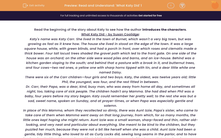Read the beginning of the story about Katy to see how the author introduces the characters.
You may find it useful to read it through a couple of times, noting down the most important information and events. Writing a short summary of each paragraph will also help you to find answers to each question more quickly and efficiently.
What Katy Did - by Susan Coolidge:
Katy's name was Katy Carr. She lived in the town of Burnet, which wasn't a very big town, but was growing as fast as it knew how. The house she lived in stood on the edge of the town. It was a large square house, white, with green blinds, and had a porch in front, over which roses and clematis made a thick bower. Four tall locust trees shaded the gravel path which led to the front gate. On one side of the house was an orchard; on the other side were wood piles and barns, and an ice-house. Behind was a kitchen garden sloping to the south; and behind that a pasture with a brook in it, and butternut trees, and four cows — two red ones, a yellow one with sharp horns tipped with tin, and a dear little white one named Daisy.
There were six of the Carr children — four girls and two boys. Katy, the oldest, was twelve years old; little Phil, the youngest, was four, and the rest fitted in between.
Dr. Carr, their Papa, was a dear, kind, busy man, who was away from home all day, and sometimes all night, too, taking care of sick people. The children hadn't any Mamma. She had died when Phil was a baby, four years before my story began. Katy could remember her pretty well; to the rest she was but a sad, sweet name, spoken on Sunday, and at prayer-times, or when Papa was especially gentle and solemn.
In place of this Mamma, whom they recollected so dimly, there was Aunt Izzie, Papa's sister, who came to take care of them when Mamma went away on that long journey, from which, for so many months, the little ones kept hoping she might return. Aunt Izzie was a small woman, sharp-faced and thin, rather old-looking, and very neat and particular about everything. She meant to be kind to the children, but they puzzled her much, because they were not a bit like herself when she was a child. Aunt Izzie had been a gentle, tidy little thing, who loved to sit as Curly Locks did, sewing long seams in the parlor, and to have her head patted by older people, and be told that she was a good girl; whereas Katy tore her dress every day, hated sewing, and didn't care a button about being called "good," while Clover and Elsie shied off like restless ponies when any one tried to pat their heads. It was very perplexing to Aunt Izzie, and she found it hard to quite forgive the children for being so "unaccountable," and so little like the good boys and girls in Sunday-school memoirs, who were the young people she liked best, and understood most about.
.jpg)








